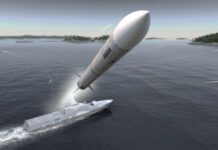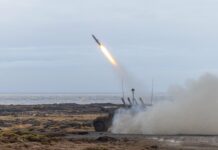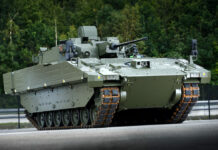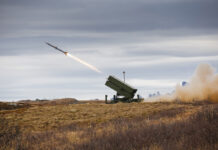Given the high cost of developing high-technology weaponry, any approach that promises to save time and money is of potential value. When the British Army took its latest surface-to-air missile into service at the end of 2021, it was not only fielding a replacement for the ageing Rapier system, but was also showing how an effective weapon can be developed by exploiting existing technology, and combining this with carefully-selected new developments.
The’ all-new’ approach to developing military hardware has traditionally been favoured by the UK, but has often resulted in programmes that ran over-budget and well behind schedule. However, reusing technology from MBDA’s Advanced Short Range Air-to-Air Missile (ASRAAM) short-range air-to-air missile and combining this with state-of-the-art developments has allowed the UK to develop two short-range SAM systems based on a common missile – the Sea Ceptor system for the UK’s Royal Navy, and the Sky Sabre for the British Army.

The Emerging Requirement
Creation of a radar-guided short-range SAM system able to operate by day or night in all weather conditions was not practical during the second half of the 20th century. Semi-automatic command to line-of-sight (SACLOS) guidance offered a simpler solution, and was used by the UK for the Rapier, which used optical SACLOS, with a later add-on radar automatic command to line-of-sight (ACLOS) capability, and Seawolf, which used optical SACLOS and radar-based and ACLOS modes.
By the early years of the 21st century the UK faced the problem that Rapier and Seawolf would both need to be replaced around 2020 when these were expected to reach the end of their respective service lives. Replacement systems would have to cope with a target set that included fast jets, helicopters, cruise missiles, and unmanned aerial vehicles. MBDA described potential future targets as being “typified by high speed, rapid evasive manoeuvres, low signatures and advanced countermeasures”.
By that time, radar guidance technology had progressed to the point where it seemed possible to use this in a new lightweight missile able to deliver all-weather day and night capability. MBDA (then MBD) and the UK MoD’s Defence Evaluation and Research Agency (DERA; now succeeded by Dstl) jointly funded a first-phase CAMM technology development programme (TDP) to work on several critical technologies including a soft vertical launch (SVL) demonstrator, a low-cost active radar seeker, and a dual-band two-way datalink.
The Quest for Soft-Launch
Previous UK-designed SAM systems had relied on traversable launchers, a solution retained for Rapier and the original GWS-25 version of Seawolf, but the GWS-26 version of Seawolf first fielded in the 1980s marked the first use by the UK of the hot vertical launch technique. It teamed the basic Seawolf missile with a booster motor and turnover pack that separated after use. This configuration increased the range of the system from 6.5 km to 10 km. However its use against short-range targets is reported to have sometimes involved the missile and booster making a post-launch manoeuvre of more than 180° in elevation, which briefly resulted in these heading back towards the launch ship before executing a sharp turn that brought the combination onto a low-level trajectory heading away from the ship and towards the target.
Although vertical launching was adopted for many SAM systems, the hot-launch technique that these used posed several problems. One was the need to cope with the efflux generated if the rocket motor of the missile or booster was ignited in the launch cell. Another was the need to expend a portion of the boost-phase energy on the task of orienting the missile in the required direction. There was also the possibility that a malfunctioning missile which has failed to leave the launcher could destroy its launch cell and damage neighbouring cells.
Cold vertical launch is an alternative technique in which the missile is ejected from its storage container by a mechanism such a telescoping rod or captive piston driven by the efflux from a gas generator. Once the missile is clear of the launch container, an orientation system such as sideways-firing thrusters turns the weapon in the direction of the target. Once this has been done, the missile’s rocket motor is ignited, and powered flight begins. The entire burn time is used to power the missile toward the target. Since the missile has been vertically launched, the system has a full 360° coverage. This avoids the need to fly energy-bleeding ‘over-the-shoulder’ manoeuvres that would decrease the range performance of a missile launched to engage a rear-sector target.

It should be noted that cold vertical launch technology is not altogether new, having been used by the Soviets starting in the late-1970s on the S-300P family, and subsequently implemented on the Tor, S-300V, S-400, S-350, and S-500 air defence system families. However, it has been a comparatively rare sight on Western air defence systems, which have tended toward either hot vertical launch or traversable launchers.
Between 2002 and 2005, MBDA conducted a series of demonstration firings in order to demonstrate the planned soft-launch scheme. These trials used a missile about 3 m long, whose all-up weight was about 100 kg, slightly more than the 87 kg of the ASRAAM. If a standard ASRAAM motor had been used, this would have created a range-safety problem.
Before conducting a missile test, engineers the need to define the area of terrain that a missile flight will place at risk. The ‘worst case’ from the point of view of safety is that a newly launched missile will turn to face the worst-possible direction, then make no further manoeuvres but fly until it runs out of energy. The resulting distance from the launch point may be inconveniently long, but any location closer to the launch point could be at risk from a malfunctioning missile. In the event of a guidance failure, the missile used for these early cold vertical launch trials could have landed up to 60 km from the launch point if powered by an off-the-shelf ASRAAM rocket motor. So, in order to meet range-safety requirements, a short-burn version of the ASRAAM motor was used for these test firings.
One interesting feature of the chosen configuration was that the eight side-firing thrusters (arranged as four pairs located directly below the control fins) were a permanent part of the missile, rather than being located in a tail-mounted subunit that could be jettisoned after use. Although releasing the spent thruster unit would have reduced the weight of the missile before beginning powered flight, the resulting weight saving would be offset by the weight of the missile-mounted hardware needed to conduct the jettisoning. The latter would also have added a potential failure mode to the weapon.
Developing the Technology
A joint MoD/MBDA initiative into multi-role modular seekers was begun in 2001. The goal was to create hardware that would allow excellent target discrimination plus good resistance to the effects of clutter, glint, and jamming. Speaking at the DSEI 2013 exhibition in London, Steve Wadey, executive group director technical and managing director UK of MBDA, described gallium nitride (GaN) solid-state power amplifier technology as being a key feature of the new seeker. To minimise the cost, the transmitter section of the prototype hardware operated at a lower power level that that planned for an operational version.
By 2005, MBDA envisaged the creation of a single multi-role missile able to replace the AIM-9M Sidewinder and ASRAAM air-to-air missiles, as well as the Starstreak, Rapier and Seawolf surface-to-air missiles. A second phase TDP launched in 2008 included the manufacture of flightworthy subsystems, mid-course guidance firings, further soft vertical launch trials, and captive airborne trials of the seeker.
The Naval Requirement Takes Priority
By 2009 the CAMM programme was in the Assessment Phase of the UK procurement cycle, with development of what was now termed the Future Local Area Air Defence System (FLAADS) due to begin in 2010. The initial application envisaged was for a naval SAM variant designated Sea Ceptor. This was planned as a retrofit to the Royal Navy’s Type 23 frigates from 2016 onwards in order to replace the aging Seawolf surface-to-air missile system, then as the primary air-defence system for what were then the planned Type 26 frigates. In January 2012 the MoD awarded MBDA a GBP 483 million contract to develop FLAADS (Maritime), and the system entered service in 2018 under the designation ‘Sea Ceptor’.
The assessment phase for the land-based version (then known as FLAADS Land) began with a GBP 36 M contract from the UK Ministry of Defence (MOD) in 2014. This would study integration of the CAMM missile into a land-based launcher, as well as the command and control facilities needed for the new role, and interfacing with suitable radar systems that were either already in UK service or planned for future service.
The Land-Based Solution
Sky Sabre combines the MBDA launcher and its associated missiles with a SAAB Giraffe Agile Multibeam (AMB) radar and a Rafael Surface to Air Missile Operational Centre (SAMOC; also referred to as the Tactical Operations Centre (TOC), which serves as the command post. A battery will typically consist of a command post, a multifunctional radar, four to six transporter, erector, launchers (TELs), plus associated supporting assets.

The system was not designed to launch missiles whilst on the move. Before an engagement can begin, the radar, command post, and the associated launchers must be emplaced and set up. The use of RF links avoids the need to deploy, connect, and restow conventional cables. This greatly reduces setup and teardown time, but could make the system potentially more vulnerable to enemy EW measures.
Rafael Meets the Command Post Requirement
The command post is based on a Rafael Advanced Defense Systems Modular Integrated C4I Air & Missile Defense System (MIC4AD). Designed for use with a range of possible air and missile defence systems, this is able to correlate data from distributed sensors such as radars, IFF systems, and information available via data links in order to create a real-time, coherent national air situation picture, and also incorporates a mission planning system.
The operators are able to carry out threat assessment and classify hostile targets, and generate interception plans. MIC4AD links the radar with the missiles, guiding the latter towards their individual targets.
Sweden Provides the Radar
Giraffe AMB is a C-band (4–8 GHz) passive electronically scanned array radar able to provide full 360-degree situational awareness out to a range of 120 km, and with an elevation coverage of up to 70° in elevation, and an update rate of 60 times per minute. Developed by Saab, it was designed to cope with coastal or mountainous terrain, and to reject radar clutter from birds or wind farms. An extending mast allows the antenna unit to be elevated above tree lines and other obstructions in order to maximise performance against low-flying intruders.
Once the radar vehicle has reached its planned operating location, stabilisers are lowered, and the radar antenna is raised from its transport location flat against the shelter roof up to its full height of 12 m above the shelter structure. An extending telescopic mast that houses the AMB’s communications antenna is also raised.
An Agile Launcher Takes Shape
In developing the launcher, MBDA was able to take advantage of the experience it had gained having used a truck-mounted missile launcher for early CAMM test launches. First displayed at the 2011 DSEI exhibition in London, this trials unit was based on a MAN 6×6 truck, and carried two packs of six missiles. Three or six canisters from each pack could be raised and lowered independently for reloading, while the others remained ready for use.

For the purposes of Sky Sabre, a launcher module is installed on a Rheinmetall MAN HX77 8×8 heavy utility truck, a vehicle already in British Army service. Like the radar vehicle, the launch vehicle is fitted with stabilisers which allow the vehicle to raise two telescoping masts, one for a communications mast that provides a high-bitrate datalink for wireless communication with the other battery components, and the other for an optoelectronic sight thought to incorporate an IR camera. This probably allows the vehicle to passively acquire and track targets in cases where the multifunctional radar may not be able to detect the target or has been forced to shut down due to the threat posed by enemy anti-radiation missiles. Although the optoelectronic sight is thought to be capable of tracking a missile and its target, and generating mid-course guidance corrections for the missile, this has not been officially confirmed.
The launch assembly consists of a frame on which two packs of four containers for ready-to-launch missiles are mounted. The containers are angled slightly away from vertical, in order to prevent a newly-launched missile from falling back onto the launcher should its rocket motor fail to ignite. An electro-hydraulic mechanism is used to elevate or depress the entire assembly, while a second mechanism is available to extend and retract a hook arm. This arrangement allows the vehicle to self-load and unload the complete frame with missiles to and from a nearby missile transporter truck. There is no need for a separate loader or transloader vehicle. The individual launch containers are sealed, and should give the missile an estimated storage life of at least 20 years.
In terms of launching the missile, when launch is initiated, hot gas created by a pyrotechnic generator drives a piston located below the missile up the length of the container. This process expels the missile, which breaks through a frangible a lid at the top of the container. Once the missile is clear of the launch container, its four cropped-delta control fins unfold ready for use, but the piston remains trapped at the top of the tube, so that the efflux from the gas generator does not escape. This reduces the launcher’s thermal signature, and prevents the efflux from damaging the launcher hardware.
Ground-Controlled then Autonomous
Once a missile has been launched and has competed its boost phase, it flies under the control of its INS-based autopilot. Mid-course guidance corrections transmitted by the radar are received by the missile, but the location of the missile-mounted antennas used to receive these updates has never been revealed by MBDA or the UK MoD. One possible location is within the inboard section of missile’s cruciform steering fins. This would require an RF connection able to pass signals through the fin’s pivots, then use the same route past the missile’s solid-propellant rocket motor as the electronic connections used to carry commands to the actuators that move the steering fins.
Guidance corrections are provided until the missile’s seeker is able to independently acquire the target – the technique known as lock-on after launch (LOAL). The missile seeker then tracks the target, and an on-board processor calculates the course corrections required to achieve intercept, then passes steering commands to the flight-control surfaces. A laser proximity fuze is used to activate a warhead thought to weigh about 10 kg.

It is worth noting that the guidance system may be more complex than the above description implies. Since the initial CAMM technology development programme was reported to have studied a dual-band two-way datalink, it is possible that the missile may have a downlink capability able to pass data back to the ground systems. This could allow several guidance-related functions. For example, ground-based monitoring of the performance of the seeker during its active phase might allow the sending of a command to change seeker parameters, in order to optimise its end-game performance, or to blunt the effects of enemy countermeasures.
Entry into Service
By October 2021, Britain had already sent a Sky Sabre battery to the Falkland Islands. Following this, on 6 December 2021, the UK’s Defence Equipment & Support (DE&S) organisation announced that it had delivered the first Sky Sabre system to the British Army. The first unit to be equipped was 16 Regiment Royal Artillery, part of the British Army’s 7 Air Defence Group.
During the July 2022 NATO summit meeting held in the Lithuania city of Vilnius, the alliance agreed to enhancements of its Integrated Air and Missile Defence posture, including the rotational deployment of modern air defence systems across the eastern flank.
On 17 March 2023 UK Secretary of State for Defence Ben Wallace announced the planned deployment of British Army Sky Sabre units to Poland. Although unannounced, the first hardware and personnel from the Royal Artillery’s 11 (Sphinx) Battery probably reached Poland in late-April. Initial operating capability (IOC) of what was termed the Medium Range Air Defence Contingency Force was announced on 23 May 2023.
Sky Sabre Assessed
Although the CAMM missile inherited much of its technology from ASRAAM, and uses many components from latter, including the main fuselage, rocket motor, laser proximity fuze, and warhead, it represents a major step forward in short-range SAM capability. While the US attempt to combine two different guidance systems in the General Dynamics Mauler short-range SAM some 60 years ago was unsuccessful, MDBA engineers were now able to do this with great success, and in a missile weighing 99 kg, just over twice the weight of the 43 kg Rapier Mk2B that it would replace, and less than two-thirds the weight of the 165 kg 9M331 vertically-launched missiles used by Russia’s 9K331 Tor-M1 (SA-15 ‘Gauntlet’) short-range SAM system.
No details have been released concerning the missile’s accuracy, but according to Major Tim Oakes, the senior training officer for the 16 Regiment Royal Artillery unit’s training programme, “Sky Sabre is so accurate and agile that it is capable of hitting a tennis ball-sized object travelling at the speed of sound…it can control the flight of 24 missiles simultaneously whilst in flight, guiding them to intercept 24 separate targets.”
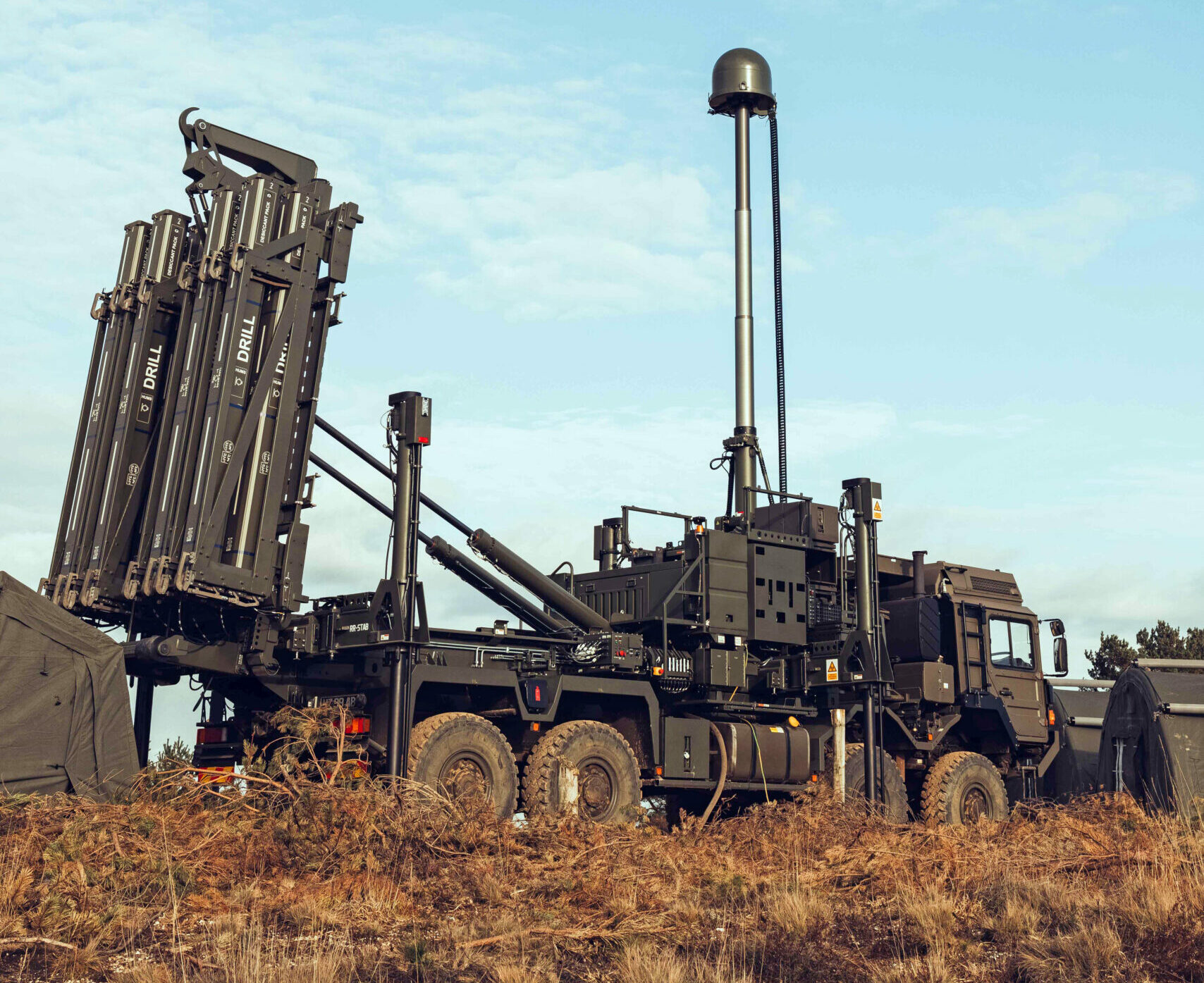
In terms of maximum range, it eclipses older systems such as Rapier and Tor. While the Rapier could manage only 8.2 km, and Tor (depending on the variant) has a range of up to 12 km (using 9M331), 15 km (using 9M331D), or 16 km (using the newest 9M338K). By contrast, CAMM can be used against targets over 25 km away, and as such the British Army considers it to be a medium-range system.
It is worth noting that the 25 km figure for CAMM represents useable range against a realistic target, rather than a theoretical maximum range. As described earlier, the hardware used for early flight tests would have imposed a safety distance of 60 km had a standard ASRAAM rocket motor been used. However, this does not imply that CAMM has anything like this as its maximum range. In combat, the target is unlikely to be flying straight and level, but could well be manoeuvring either to avoid an incoming missile, or to accomplish its own mission. Wayward SAMs can impact the ground many times further than their practical range against aerial targets, as was the case in 2019, when a stray Syrian S-200VE landed in Cyprus, over 220 km from its launch point.
Like any other missile fired against an air target, CAMM is subject to the missile engineer’s ‘rule of thumb’ that it needs to be able to pull a manoeuvre involving five times the ‘g’ of any defensive manoeuvre executed by the target. The resulting expenditure of energy by the missile will reduce its range to well below the safety distance used during missile trials. So that figure of over 25 km for the maximum range of CAMM represents a real-world value for a tactical engagement. That said, a hostile aircraft unable or unwilling to conduct hard anti-missile manoeuvres might find it advisable to keep a slightly greater distance from a Sky Sabre battery.
Doug Richardson





